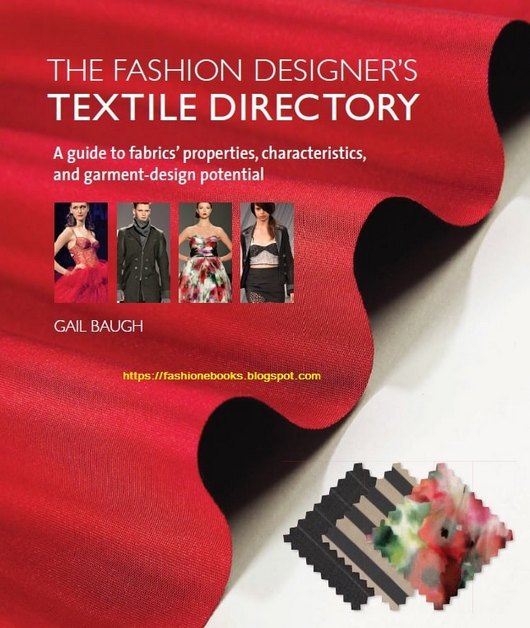by Gail Baugh

Contents
Author’s foreword 9
About this book 10
SECTION ONE:
Responsible design 14
The future of fabric production 16
SECTION TWO:
The language of textiles 20
The supply chain 22
Fabric orientation 24
Fiber 26
Yarn 33
Fabrics 35
Adding color 40
Finishing 43
Garment care 47
SECTION THREE:
Introduction to the directory 50
Chapter one: Structure 52
Lawn 56
Calico 57
High-density fabrics 58
Broadcloth 60
Poplin 61
Checks and plaids 62
Oxford 64
Surface shine: ciré and chintz 66
Puckered surface: seersucker and plissé 67
Dobby weaves 68
Taffeta 70
Faille and bengaline 72
Shantung 73
Sateen 74
Bridal satin 75
Flannel 76
Flannelette 77
Linen 78
Sheeting 80
Muslin 81
Canvas 82
Homespun 84
Hopsacking 85
Denim 86
Gabardine 90
Chino 91
Serge 92
Cavalry twill 93
Ripstop 94
Ottoman 95
Dobby weaves for suiting 96
Tweeds 98
Jacquard weaves 100
Velveteen 102
Corduroy 104
Brushed fabrics 106
Fabrics from fiber 108
Melton 110
Double knits 112
Coated fabrics 114
Microporous laminated fabrics 116
Film fabric 118
Leather 120
Suede leather 122
Faux leather and suede 124
Bonded and fused fabrics 126
Supporting structure 128
Interlinings for structure 130
Chapter two: Fluidity 132
Chiffon 136
Georgette 137
Voile 138
Gauze 139
Lining 140
Satin 142
Crêpe de Chine 144
Crinkled fabric 146
Challis 148
Surah 149
Jersey 150
Interlock 152
Matte jersey 153
Fine-gauge sweater knits 154
Pointelle knits 156
Mesh 158
Tricot 160
Traditional lace 162
Mass-market lace 164
Lamé 166
Textured knits 168
Designed knit surfaces 170
Satin crêpe 172
Textured crêpe suiting 174
Smooth-surface crêpe 176
Tricot for athletics 178
French terry 180
Polar fleece 182
Velour 184
Velvet 186
Medium-weight sweater knits 188
Heavyweight sweater knits 190
Chapter three: Ornamentation 192
Contrast fabric shapes 196
Contrasting fabric: creating lines and
outlines with fabric 198
Functional tapes 200
Decorative ribbon: satin and velvet 202
Decorative ribbon: grosgrain and taffeta 203
Decorative ribbon: jacquard 204
Decorative ribbon: dobby design 205
Passementerie trim 206
Fringe 208
Narrow novelty trims 210
Narrow closure trims 212
Lace edging and appliqués 214
Embroidery 216
Embroidery threads 217
All-over embroidered fabrics 218
Garment-specific embroidery 220
Embroidered denim 222
Chapter four: Expansion 224
Netting 228
Organza 230
Organdy 231
Crinoline 232
Buckram 233
The concept of pleating 234
Pleated silk fiber fabrics 236
Pleated cotton fiber fabrics 237
Polyester plain-weave pleated fabrics 238
Crêpe and satin crêpe pleated fabrics 239
Stitched pleating 240
Shirring 242
Bouclé 244
Chenille 245
Terry cloth 246
The concept of quilting 248
Minimum-loft quilting 249
Medium-loft quilting 250
High-loft quilting 252
Fur in apparel 254
Repurposed fur 255
Commonly used faux fur 256
Exotic faux fur 258
Chapter five: Compression 260
Compression with rigid fabrics 264
Ribbed knits 266
Elastic ribbed knit banding 268
Comfort stretch: top weights 270
Comfort stretch: casual woven fabrics 272
Comfort stretch: stretch denim 274
Comfort stretch: stretch suiting 276
Comfort stretch: double knits 278
Power stretch: athletic knits 280
Power stretch: underwear knits 282
Power stretch: elastic power mesh 284
Power stretch: narrow elastic bands 286
SECTION FOUR:
Introduction to the charts 290
Balanced plain weave 292
Unbalanced plain weave 294
Textured weave/Jacquard weave 296
Pile weave/Basketweave 298
Twill weave 300
Satin weave 302
Weft knit 304
Weft pile knit/Warp knitting 306
Warp pile knit/Jacquard warp knit 308
Fiber to fabric/Lace 310
Glossary 312
Resources 315
Index 316
Credits and acknowledgments 320
About this book
This comprehensive guide to fashion textiles comprises four sections: an introduction to the role of the designer; an examination of the textile industry; an exhaustive directory of the textiles available to the designer, and a series of at-a-glance charts: it is a go-to reference for the designer.
Section one: Responsible design (pages 14–19)
This section is an introduction to the ecological and social responsibilities of the designer, and it includes in-depth discussion of how fashion designers can work toward a sustainable textile industry.
Section two: The language of textiles (pages 20–47)
This section discusses the role of designers in the fashion and textile industries and explains everything you need to know in order to understand and communicate with fabric producers and suppliers: it includes information on everything from fiber, yarn, and fabric production to finishing processes such as dyeing and printing.
Section three: The textile directory (pages 48–287)
This comprehensive directory of textiles features everything from natural-fiber textiles such as linen and cotton to the latest technological manmade fabrics. It is organized into five color-coded chapters intended to lead the designer quickly to the right fabric.
Section four: The charts (pages 288–311)
The guides are a series of informative charts, which condense and present a lot of the information at the heart of the directory into highly functional tables. Organized by fabric structure—weave, knit, or massed fiber—they give information on fiber content, yarn type, fabric names, fabric weight, advantages and disadvantages, any finishes, and end use. The charts include the icons, cross refer to directory page numbers, and are color-coded so that you can easily find the relevant chapter in the directory.

Its very much informative; like the list of books